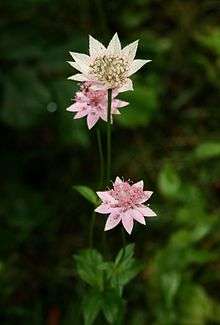Astrantia maxima
Astrantia maxima, (largest masterwort[3]), is a species of flowering plant in the family Apiaceae.
| Astrantia maxima | |
|---|---|
 | |
| Scientific classification | |
| Kingdom: | |
| (unranked): | |
| (unranked): | |
| (unranked): | |
| Order: | |
| Family: | |
| Genus: | |
| Species: | Astrantia maxima |
| Binomial name | |
| Astrantia maxima | |
| Synonyms | |
Growing to 90 cm (35 in) tall by 60 cm (24 in) broad, it is an herbaceous perennial, used in gardens. It is hardy to USDA Zone: 4-9.[4] It has gained the Royal Horticultural Society's Award of Garden Merit.[3][5]
Description
Astrantia maxima reaches on average 90 centimetres (35 in) of height. The stem is erect and glabrous, with little branches and few leaves. The basal leaves have a long petiole 10–20 centimetres (3.9–7.9 in), 3 to 7 lobes and toothed segments. Size: 8–15 centimetres (3.1–5.9 in). The cauline (borne on the stem as opposed to basal) leaves are generally two, sessile, amplexicaul and lanceolate-shaped with a trilobed apex. The inflorescence is umbrella-shaped, 2–3 centimetres (0.79–1.18 in) in diameter. The floral bracts are numerous (10 - 20), 10–18 millimetres (0.39–0.71 in) long, pinkish (sometimes white) with acuminate apex. The small flowers are pinkish-white. The central ones are hermaphrodite, while the external ones are male. The flowering period extends from May to July.[6]
Reproduction
Astrantia maxima is an entomophilous plant, mainly pollinated by beetles, but also by other insects. This perennial plant reproduces itself also by means of buds present at the ground level. The plant can also be grown from seed for garden usage. The seeds require a 2-3 month period of cold stratification for germination to take place.[7]
Taxonomy
It was found by botanist Peter Simon Pallas[6] in 1790.[8] It was first published and described by Pallas in 'Nova Acta Acad. Sci. Imp. Petrop. Hist. Acad.' Vol.7 on page 357 in 1793.[2][9]
It was also previously known as the 'hellebore-leaved masterwort'.[8]
Etymology
The specific epithet maxima, meaning "largest",[10] distinguishes this species from its smaller relatives Astrantia minor and Astrantia major.
Distribution and habitat
These plants, native to Europe, are widespread in the Caucasus. They have been grown in the British Isles since 1804.[8]
In Turkey, they are common in woodlands and lush meadows, at an altitude of 1,300–2,400 metres (4,300–7,900 ft) above sea level.[11]
Also common in Turkey is the subspecies Astrantia maxima Pallas subsp. haradjianii.[12]
Cultivation
Astrantia maxima grows well in the garden, given some shade and moisture. Its flowerheads provide summer colour in shades of red, pink and white. It is also rabbit resistant.[13] It is rated for hardiness, USDA zones 5 to 9.[14]
Cultivars
- Astrantia major 'Hadspen Blood' is a hybrid of Astrantia major and A. maxima.[15]
- Astrantia maxima 'Mark Fenwick', listed on some nurseries and recently onto the RHS Catalogue.[16]
- Astrantia maxima 'Rosea', listed on some nurseries but not on RHS Catalogue.[17]
References
- "Astrantia maxima". rhs.org.uk. Retrieved 6 June 2014.
- "Astrantia maxima Pall. is an accepted name". plantlist.org. 23 March 2012. Retrieved 19 January 2018.
- "RHS Plantfinder - Astrantia maxima". Royal Horticultural Society. Retrieved 12 January 2018.
- "astrantia maxima". perennials.com. Retrieved 6 June 2014.
- "Masterwort". bbc.co.uk. Retrieved 6 June 2014.
- von Pallas, Peter Simon (2011). "Astrantia maxima". alpinegardensociety.net. Retrieved 13 June 2014.
- "How to Grow, Propagate and Care for Masterwort Plants". thegardenhelper.com. 2014. Retrieved 7 June 2014.
- Sims, John. Curtis's Botanical Magazine, Or, Flower-garden Displayed, p. 1553, at Google Books
- "Apiaceae Astrantia maxima Pall". Retrieved 19 January 2018.
- Stearn, William (1972). A Gardenerer's Dictionary of Plant Names. London: Cassell. p. 211. ISBN 0304937215.
- Kaya, Ayla (2003). "The genus Astrantia L. in Turkey: morphology and anatomy". hrcak.srce.hr. Retrieved 6 June 2014.
- Kandem, Ali (8 May 2007). "The Flora of Üzümlü -Sakaltutan (Erzincan-Gümüflhane)" (PDF). Erzincan University. p. 6. Archived from the original (pdf) on 3 March 2016. Retrieved 13 June 2014.
- Austin, Claire. "Astrantia maximaMasterwort". claireaustin-hardyplants.co.uk. Retrieved 6 June 2014.
- Boland, Todd (19 December 2009). "Masterful Masterworts". davesgarden.com. Retrieved 9 June 2014.
- The Horticulture Gardener's Guides - Perennials. p. 2.
- "Astrantia maxima 'Mark Fenwick'". zipcodezoo.com. Archived from the original on 7 June 2014. Retrieved 7 June 2014.
- "Astranita page". tripod.com. 2002–2004. Retrieved 7 June 2014.
![]()